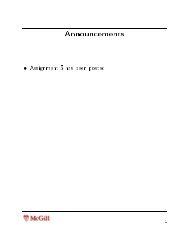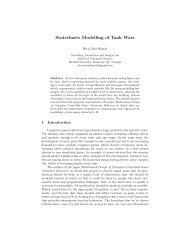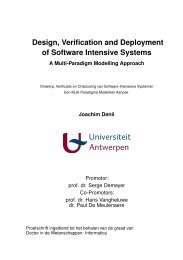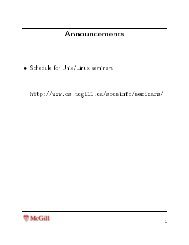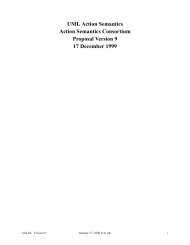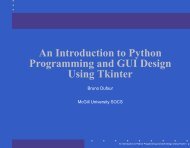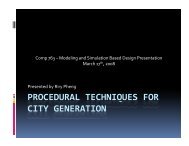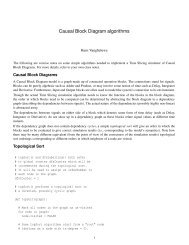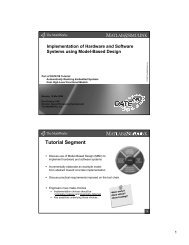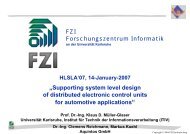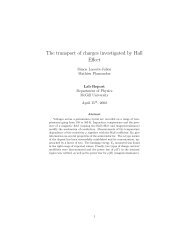Presentation - MSDL
Presentation - MSDL
Presentation - MSDL
You also want an ePaper? Increase the reach of your titles
YUMPU automatically turns print PDFs into web optimized ePapers that Google loves.
Feature Modelling:<br />
A Survey, a Formalism and a Transformation for Analysis<br />
Thomas De Vylder
Feature Modelling Origins<br />
Content<br />
Feature Modelling Notations & Definitions<br />
AToM³ Meta-Model<br />
Formal Analysis of Feature Models<br />
+ Operations<br />
+ Model Transformation To Alloy<br />
Beware<br />
Demo
Feature Modelling Origins
Feature Modelling Origins<br />
• First introduced in Feature-Oriented Domain Analysis<br />
(FODA) method*<br />
– FODA is the Domain Analysis component of Model Based<br />
Software Engineering (MBSE)<br />
– Feature modelling captures the commonalities and variabilities<br />
in terms of features of systems in a domain<br />
• Vigoriously used in the Software Product Line (SPL)<br />
community<br />
– SPL is identified by a unique and legal combination of features<br />
* Kang, K. C., Cohen, S. G., Hess, J. A., Novak, W. E., Peterson, A. S., November 1990. Feature-oriented domain analysis (foda) feasibility study.<br />
Tech. rep., Carnegie-Mellon University Software Engineering Institute.
Feature Modelling Notations & Definitions
Feature Modelling Notations & Definitions<br />
• Based on this diagram of a model:
Feature Modelling Notations & Definitions<br />
• Concept
Feature Modelling Notations & Definitions<br />
• Features
Feature Modelling Notations & Definitions<br />
• Mandatory Features
Feature Modelling Notations & Definitions<br />
• Optional Features
Feature Modelling Notations & Definitions<br />
• OR Features (at least one)
Feature Modelling Notations & Definitions<br />
• Alternative (XOR) Features (one and only one)
Feature Modelling Notations & Definitions<br />
• Sets (XOR, OR) with optional features<br />
– Can be normalized<br />
• Cross graph constraints can exist<br />
– “All TrafficCars with an automatic transmission<br />
must have a LogicUnit”<br />
– “All TrafficCars with a manual transmission may<br />
not have a LogicUnit”
AToM³ Meta-Model
AToM³* Meta-Model<br />
• Concept/Feature (no distinction!)<br />
– Name (must start with capital letter)<br />
– SemanticDescription<br />
– Rationale<br />
– StakeholdersAndClientPrograms<br />
– ExemplarSystems<br />
– Priority<br />
• Port (Inheritance: Optional/Mandatory)<br />
• Subset (Inheritance: XOR/OR)<br />
• Constraint<br />
– Name (must start with capital letter)<br />
– Constraint (textual relational language Alloy)<br />
• Comments<br />
– Content<br />
* De Lara, J., Vangheluwe, H., Posse, E., A. Vasudeva Murthy, I., Provost, M., Liang, W., 2002. AToM3 A Tool for Multi-formalism and Meta-<br />
Modelling. URL http://atom3.cs.mcgill.ca/index html
AToM³ Meta-Model
Formal Analysis of Feature Models
Formal Analysis of Feature Models<br />
• Which operations must be included?*<br />
– no consensus<br />
• Possible tasks:<br />
– Determine the satisfiability<br />
Is a product represented by the feature model?<br />
– Dead feature<br />
Can a product represented by the feature model have<br />
this feature?<br />
– Find a product<br />
– Obtain all products<br />
– ...<br />
* Benavides, D., Ruiz-Corts, A., Trinidad, P., Segura., S., 2006. A survey on the automated analyses of feature models. In: Jornadas de Ingeniera<br />
del Software y Bases de Datos (JISBD).
Formal Analysis of Feature Models<br />
• Problem: no analysis tools that run on my<br />
feature models<br />
• Solution: model transformation!<br />
• Transform to?<br />
– Alloy*: a textual modelling language based on first<br />
order relational logic.<br />
* Jackson, D., 2002. Alloy Analyzer website. URL http://alloy.mit.edu/
Formal Analysis of Feature Models<br />
• Alloy<br />
– Signatures<br />
– Fields<br />
– Facts<br />
– Asserts<br />
– Predicates<br />
– some X<br />
– no X<br />
– one X<br />
– lone X<br />
– all x: X | formula<br />
– some x: X | formula<br />
– no x: X | formula<br />
– one x: X | formula<br />
– lone x: X | formula
Formal Analysis of Feature Models<br />
• Model Transformation<br />
Source<br />
Meta-model<br />
conforms to<br />
Source<br />
Model<br />
refers to refers to<br />
Transformation<br />
Definition<br />
executes<br />
reads outputs<br />
Transformation<br />
Target<br />
Meta-model<br />
conforms to<br />
Target<br />
Model
Formal Analysis of Feature Models<br />
• Model Transformation<br />
TransformerFM<br />
2Alloy.py<br />
Transformation
Formal Analysis of Feature Models<br />
• Model Transformation<br />
– metadata comments + module name<br />
– features/concepts signatures with same name<br />
– relations fields with constraints/facts<br />
– cross graph constraints facts<br />
• Extra:<br />
– comments to create structure<br />
– assertions to check for dead features<br />
– predicates/facts and runs for product finding and<br />
determining the satisfiability
Beware
• <strong>Presentation</strong> ⊂ Paper<br />
Beware<br />
– More background/detail -> read paper!<br />
– More mathematics -> read paper!<br />
– Extentions to feature models -> read paper!<br />
– Exact rules -> read paper!<br />
– Characteristics of transformation -> read paper!<br />
– …. -> read paper!
Beware<br />
• Wikipedia has other notations!<br />
– Everybody has their own notations (Czarnernecki, Kang,<br />
me, …)<br />
– I tried to be the same as Czarnernecki<br />
• Feature models are abstract<br />
– Do you want your entity of a car to have “the same” entity<br />
of an engine as the entity of the car of someone else?<br />
– Simulation/Real world requires more information
Demo



